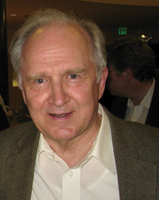Obituaries: Charles Broyden and John Osborn
July 15, 2011
Charles Broyden received a degree in physics from Kings College London in 1955 and spent the next ten years working in industry. In 1967 he moved to the University of Essex, becoming a professor and, later, dean of the School of Mathematics. In 1986 he decided to retire early to become a travelling scholar, but accepted an appointment as a professor of numerical analysis at the University of Bologna in 1990. Charles Broyden, 1933�2011
Charles Broyden, 1933�2011
Charles was a major figure in the development of quasi-Newton methods. This work was done in the 1960s and 1970s, an exciting time for nonlinear optimization. Prior to that time, gradient methods were about all we had for solving nonlinear optimization problems in which it was impractical to obtain a Hessian matrix. The developments, started by Bill Davidon in 1959 and then publicized and clarified by Roger Fletcher and Mike Powell in 1963, led to methods that could actually solve hard industrial nonlinear optimization problems.
During his years in industry, Charles decided to adapt the Davidon�Fletcher�Powell (DFP) ideas to some nonlinear systems of equations that he needed to solve at English Electric. This research led to his classic 1965 paper in Mathematics of Computation, in which he proposed two methods for solving systems of equations. These methods later became known as Broyden's good and bad methods (he called them Method 1 and Method 2), although there is still disagreement as to which is better. This work is widely recognized as one of the major developments in numerical analysis of the last century.At the University of Essex, Charles turned his attention to the DFP method for optimization. He had noticed that the method, although generally successful, had some puzzling behaviour that he attributed to rounding errors. His analysis led in 1970 to a new method with improved behaviour. It turned out that at about the same time, Fletcher, Donald Goldfarb, and David Shanno, taking different approaches, had discovered the same method. The new method was thus named the BFGS method. Other researchers have continued to analyze, develop, and improve quasi-Newton methods for optimization, but the BFGS method has withstood the test of time and is still considered the method of choice when the Hessian matrix is not available at reasonable cost.
Charles George Broyden died on May 20, 2011. Charles and the love of his life, Joan, were good friends to all of us in the field of optimization, and we were inspired by their warm, loving relationship. A dinner invitation from the Broydens generally meant a delicious meal rooted in skills Joan learned growing up in India. They had three children, Chris, Jane, and Nic, and seven grandchildren.---Oleg Burdakov, John Dennis, and Jorge Mor�.
******
John Osborn, a professor of mathematics at the University of Maryland, passed away on May 30, 2011, from complications of surgery. He was an exemplary colleague, scholar, and friend. John Osborn, 1936�2011, Photo by James Yorke
John Osborn, 1936�2011, Photo by James Yorke
John's research concerned finite element methods, with particular emphasis on eigenvalue problems. He was a leader in introducing computational methods into undergraduate mathematics courses. Through his leadership as mathematics department chair and college dean, he also made considerable contributions to the University of Maryland.
He leaves behind his wife, Janice, three children, and eight grandchildren.
John's friends echo the sentiments of the eulogy given by Ron Lipsman: "All of you who knew John well will understand me when I say that when it came to compassion, empathy, courtesy and grace, John was in a class by himself. All of us were truly blessed to have experienced his kindness, his loyalty, his understanding and his love."
A memorial fund in John's name is being established in the University of Maryland Foundation.---Ricardo Nochetto and Dianne O'Leary.

